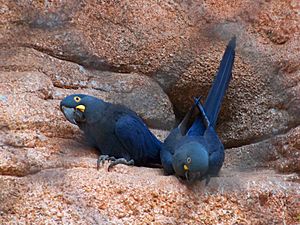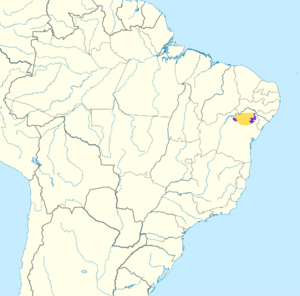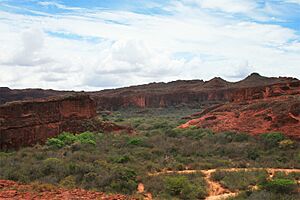Lear's macaw facts for kids
Quick facts for kids Lear's macaw |
|
|---|---|
 |
|
| Conservation status | |
| Scientific classification | |
| Genus: |
Anodorhynchus
|
| Species: |
leari
|
 |
|
The Lear's macaw (Anodorhynchus leari), also called the indigo macaw, is a large, beautiful blue parrot from Brazil. It is part of a group of parrots known as macaws. This bird was first described by Charles Lucien Bonaparte in 1856.
Lear's macaws are about 70 to 75 centimeters (28 to 30 inches) long. They weigh around 950 grams (2 pounds). Their bodies are almost completely blue. They have a yellow patch of skin at the base of their strong, black beak.
Even though some records of this macaw exist from the 1830s, it was not officially recognized as its own species until the late 1970s. It is a rare bird and lives in a very small area. This natural home was only found in 1978. Thanks to strong conservation efforts, the number of Lear's macaws has grown a lot in the last 20 years.
This macaw lives in a dry, bushy area called caatinga. It sleeps and builds its nests in holes found in sandstone cliffs. Its main food is the nuts from a palm tree called Syagrus coronata. It also sometimes eats maize from local farms. The way it lives seems to be connected to cattle ranching.
Contents
About the Lear's Macaw Name
The Lear's macaw was named after Edward Lear. He was a famous poet and a very talented artist. In the early 1830s, when he was a teenager, Lear published a book of drawings. These drawings showed live parrots from zoos and collections.
One of his paintings looked a lot like this macaw. At the time, he called it a 'hyacinth macaw'. This is a larger, darker bird with a different yellow patch near its beak. But not everyone agreed with his title.
About 25 years later, in 1856, Prince Charles Lucien Bonaparte officially described the species. He was a French ornithologist (bird scientist) and Napoleon's nephew. He decided to name the bird after Edward Lear. For a long time, many scientists were not sure if it was a separate species. The Lear's macaw was rarely seen. It was finally recognized as its own species in 1978. This happened when a Brazilian bird scientist, Helmut Sick, found the wild population.

What Lear's Macaws Look Like
Lear's macaws are about 70 to 75 centimeters (28 to 30 inches) long. They weigh around 950 grams (2 pounds).
Their body, tail, and wings are a dark, shiny blue. They might have a very slight green tint. Their head is a bit lighter blue. They have a patch of pale-yellow skin near the base of their beak. They also have orange-yellow rings around their eyes. Their beak is large and blackish, and their feet are dark gray.
Lear's macaws look similar to the larger hyacinth macaw and the slightly smaller glaucous macaw. You can tell the hyacinth macaw apart because it is darker blue. It also does not have a green tint and its yellow skin patch is shaped differently. The glaucous macaw is paler and has a more grayish head.
Life and Habits of Lear's Macaws
What Lear's Macaws Eat
The main food for Lear's macaws is the nuts of the Syagrus coronata palm tree. These nuts are known locally as licuri. A macaw can eat as many as 350 nuts in a day! They also eat seeds from other plants like Melanoxylon and Jatropha mollissima. Sometimes, they eat the flowers of Agave plants. They also raid local farms to eat maize (corn).
Macaws usually look for food in groups. They prefer to feed where palm trees grow together with taller trees. The flock will first choose a tall tree to watch the feeding area. A pair of macaws will then fly down to check if the palms are good for eating. If they are, the whole flock will come down.
The macaws eat the nuts directly from the palm. They tear off the tough outer part of the fruit to get to the very hard nut inside. They throw away the outer part. Their strong beaks are perfectly shaped to crack open these hard nuts. Sometimes, they fly to a better spot, like a tall tree branch or a cliff, to eat the nut. You can often find piles of cracked nut shells below these spots.
Macaws are messy eaters. They often drop whole, undamaged nuts on the ground. This helps spread the palm seeds. Also, macaws sometimes eat nuts that cattle have spit up. Cattle eat the fruit, but they often cough up the large seeds. These cleaned seeds can still grow into new palm trees. Flocks of macaws will gather where cattle rest to find these nuts.
Cattle also change the environment by creating open spaces. This might be similar to how large plant-eating animals helped shape the environment in the past. It is possible that Lear's macaws once lived alongside large herds of animals in Brazil. The palm trees might have depended on these animals to spread their seeds.
Lear's macaws can sometimes be a problem for local farmers. They often eat the maize from small farms. To help stop farmers from shooting the birds, a plan was started in 2005. Farmers who lost crops to the macaws were given bags of corn from other places. This plan helped protect the macaws.
Reproduction and Life Cycle
The mating season for Lear's macaws begins when the summer rains start, usually early in the year. It lasts until May, when the young birds are ready to leave the nest. A pair of Lear's macaws usually lays two or three eggs each year. The eggs hatch after about 29 days.
While some pairs might have three chicks, usually two chicks survive per pair. However, not all wild macaw pairs mate every year. Young macaws stay with their parents for up to a year. They become old enough to have their own chicks when they are about 2 to 4 years old.
Where Lear's Macaws Live
For about 150 years after it was first described, people only knew about Lear's macaws from birds sold in the pet trade. No one knew where the wild birds lived. Finally, in 1978, the bird scientist Helmut Sick found a wild group in Bahia, in the northeast of Brazil. Before this discovery, people thought these birds were just a different kind of hyacinth macaw.
Lear's macaws sleep and rest on sandstone cliffs. These cliffs were formed by streams cutting through rock. We know of two main groups of macaws at places called Toca Velha and Serra Branca. These are south of the Raso da Catarina area in northeast Bahia. In 1995, another resting spot with 22 birds was found about 200 kilometers (124 miles) to the west.
From these resting spots, the macaws fly around the region. They rely on groups of licury palm trees to find most of their food. This palm tree habitat used to cover a huge area in Brazil. But much of it has been cleared for farming. Cattle grazing in the palm areas also seems to harm young palm trees. This makes it hard for new palms to grow. To help with this, thousands of palm trees were planted in protected areas in the early 2000s.
Lear's macaws also need natural holes in the sandstone cliffs for their nests. The number of available nesting holes might limit how much the macaw population can grow. Because of this, some conservation groups have suggested making more artificial holes for them.
Protecting Lear's Macaws
Population and Conservation Status
The Lear's macaw is currently listed as an endangered species. This means it is at high risk of becoming extinct.
In 1983, scientists thought there were only about 60 Lear's macaws left in the world. By 1987, there were about 70. In 2000, a survey counted around 170 wild birds. Thanks to conservation efforts, the population has grown a lot. By 2004, there were 570 wild birds. In 2007, there were 751. By 2008, the number reached 960 birds.
In 2014, the Chico Mendes Institute for Biodiversity Conservation (ICMBio) counted 1,294 birds. This number grew to 1,354 in 2017 and 1,694 in 2018. Scientists now know that the population is increasing. A study in 2014 found that about 20% of the population was actively breeding each season. This means that by 2018, around 340 birds were adults able to reproduce. About 80% of the nests they watched were successful, which is very good for parrots.
Threats to Lear's Macaws
Besides losing their habitat, Lear's macaws may have been hunted in the past. More recently, in the 1990s, many were caught to be sold as pets.
Conservation Efforts
Fundação Biodiversitas bought land in 1991 to create the Canudos Biological Station. This station protects the sandstone cliffs of Toca Velha, where the macaws sleep and nest. The station was made much larger in 2007.
The Brazilian government has also created two protected areas in 2001. These areas help protect parts of the macaw's home. They are the Raso da Catarina Ecological Station and the Serra Branca / Raso da Catarina Environmental Protection Area. These areas include the Canudos Biological Station and a private ranch where many nests are found.
Today, projects to protect Lear's macaws are managed by the IBAMA. Many independent conservation groups work with local ranchers to help save the species.
Different groups and committees have been formed to help protect the Lear's macaw. These groups include Brazilian and international organizations and individuals. They advise IBAMA on how to best conserve the macaws.
Lear's Macaws in Zoos
One of the first times a Lear's macaw was seen in a public zoo was in 1900 at the Berlin Zoo. They had a special display of "the four blues," which included Lear's, glaucous, hyacinth, and Spix's macaws.
Today, Lear's macaws are very rare in captivity. They can live for a long time, possibly up to 60 years. However, the longest recorded life for a captive Lear's macaw is 38.3 years. Experts recommend keeping these parrots in very large enclosures, at least 15 meters (50 feet) long.
See also






